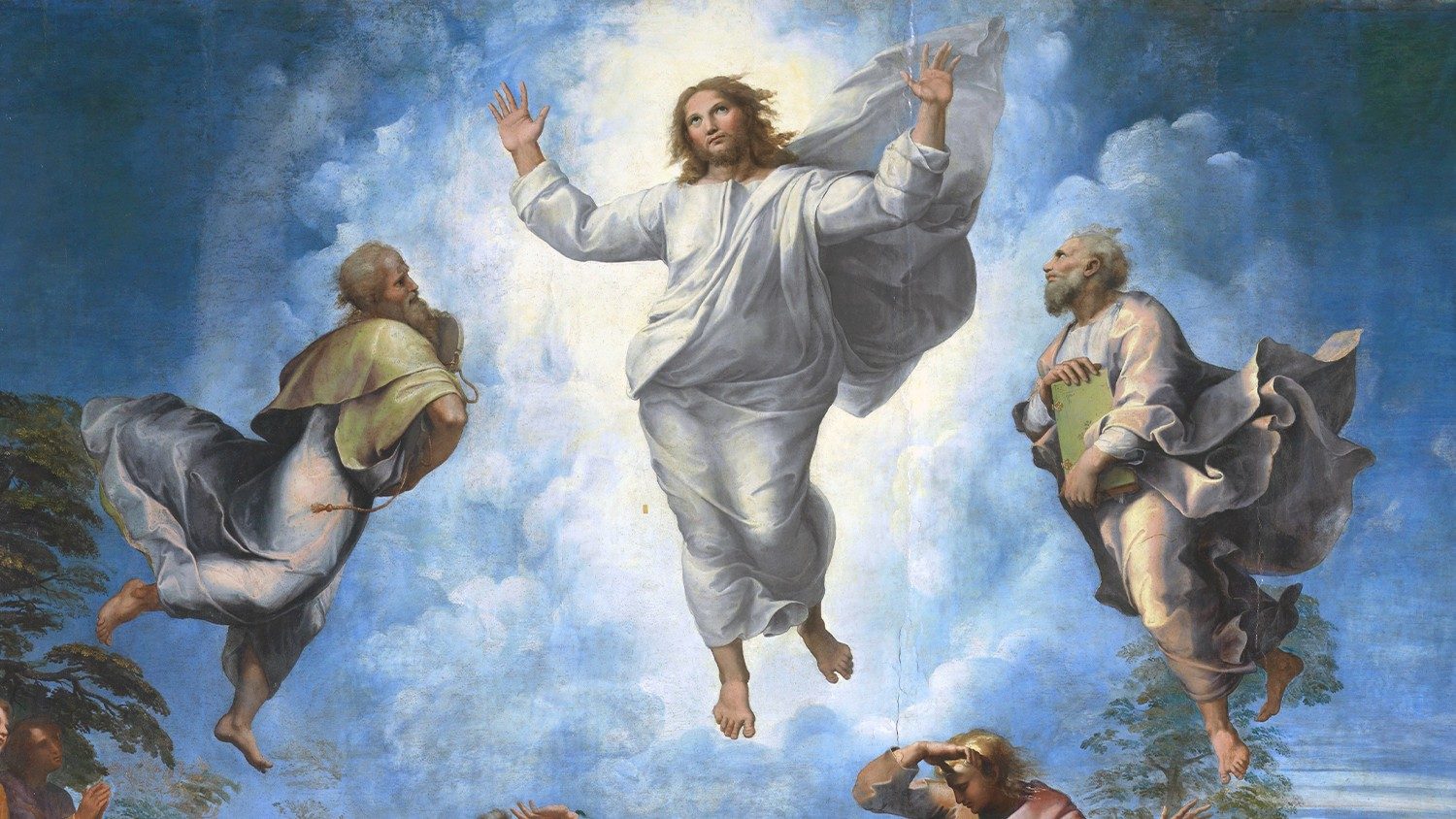
(Raphael and Giulio Romano, The Transfiguration, 1518, Pinacoteca Vaticana, Vatican City)
Second Sunday of Lent
“Laudato Si’ Journey – Sunday Gospel”
Sunday February 25th
SECOND SUNDAY OF LENT – CYCLE B
Mk 9, 2-10
This Sunday we continue the Lenten journey towards the Lord’s Easter, climbing the mountain with Jesus. What does the transfiguration of Christ mean in our lives? What can be our best response to the amazement that God generates in our hearts? Our whole existence, if we think about it, is a search for the face of God. How have men and women throughout the ages lived with this desire? It is a search for ourselves because we are made “in His image and likeness”, and we search for ourselves in the face of the one who wanted us—the one who created us with love. From the time of Adam (who hid himself from the face of God) onwards, we humans live with both the fear of seeing the face of God and the desire to say, as Peter did, “how beautiful!”
This passage takes place in the middle of Mark’s Gospel, at the end of his revelation which is accomplished with words and miracles. The gospel reveals to us, through various characters, the face of Christ. Jesus explains that he is “the son of man”, a glorious figure in the book of Daniel in chapter 7; judge of the world. Jesus completes the description of himself using the words of the prophet Isaiah, explaining that he is the “servant of Yahweh” who will have to suffer for the people in order to overcome evil. Having described himself, Jesus also describes his disciples, with great bluntness saying: “Whoever wants to come after me must take up his cross”, making us understand that following Him, His way, involves suffering. Enduring these sufferings by following His way leads to life—to ‘victory’.
In today’s Gospel, we hear the Father’s confirmation. The voice from heaven testifies to the disciples that this is indeed “the son of man”, the one who will have to suffer and God invites everyone to listen to Him. The theme is not the Transfiguration—indeed Mark himself does not even use this term. The theme of transfigurations, the μεταμόρφωσις (=”metamorphosis”) is very dear to pagan cultures in which divinities take on human form. Here, the exact opposite happens: human nature takes on the light, the “fabric” of God. In order to see God, we have to see the humanity of Jesus and it is from Him that we must take inspiration and become his disciples by listening to Him. This scene on Mount Tabor is the conclusion of God’s creative action. We can say that it is the completeness of Creation. “We know that all creation is groaning in labor pains even until now; […] we also groan within ourselves as we wait for adoption, the redemption of our bodies. For in hope we were saved.” (Rom 8, 22-24). Contemplating the beauty of this face and animated by hope, it is as if all Creation has completed this journey of desire.
“At that time, Jesus took Peter, James, and John.” Here, as often happens in the Sunday Gospel, we lose the temporal location of the passage. In reality, the passage we find in the Bible says “After six days Jesus took ...” after these speeches, these words, in which Jesus referred to the fact that he is “the Son of Man” and will have to suffer in order to bring life. The same goes for us too: if we don’t experience, or ‘live’ those words, we will never witness the transfiguration.
He takes them with him into his trust and brings them up the mountain, to the heights of Creation, the place of wisdom and prayer. The true place of transfiguration is prayer. When we enter into this father-son relationship, as Jesus had with the Father, we can experience transfiguration. Creation speaks to us and reveals the face of God to us. It is up to us to understand it and know how to interpret it. We can only change the world if we learn to “change our world, our way”; to change our gaze, to educate this contemplation in our “typical Monday”, in our everyday life. Only in this way will we be able to see the transfiguration. While He prays, a transfiguration does not take place, but ” he was transfigured before them and his clothes became dazzling white”.
Not being able to describe the face, which is “other”, he describes the dress which is very white, so white as to be supernatural. No human professional, “no launderer on earth could make them so white.” Then he describes two figures: Moses as the expression of law and the word and Elijah as the prophet who represents God’s action throughout history. He alone is the light that illuminates our faces, and so, if we are with God our face too will be “dazzling”.
Neither Moses nor Elijah saw death. The former because he received a kiss from God, and the latter because he was kidnapped by a chariot of fire. To understand the glory of God, we must turn to the Bible. They are both represented “in the glory” of Jesus and speak of “his exodus”, that is, of his death on the cross. The entire Old Testament speaks of his death and resurrection and leads towards the event that changes history.
While Moses and Elijah were “conversing with Jesus“, Peter’s curious and very beautiful intervention takes place. There is a moment of dialogue between Moses and Elijah with Jesus. The disciple’s first reaction is amazement, “how beautiful!“, which if you think about it, is the exclamation that God makes every day during Creation, when at the end of every creative act he always exclaimed “how beautiful!” Peter sees this beauty too, there on the mountain—the beauty of God through his son. It’s the same beauty that we should try to discover when looking through the face of Jesus at each of our brothers and sisters and at all of Creation! It was easy for God to be amazed by all this beauty because by looking at newly created man, He recognised his splendor.
“Let us make three tents” almost seems a prelude to the vice of building cathedrals. The tents in Hebrew שְׁכִינָה (=“Shekhinah”) recall the tabernacle, the place where the Eucharist is kept. The definitive tent is the flesh of Jesus. Peter could not even realize it, having just been awakened and struck by such beauty. God responds through creation, through “a cloud”, a sign of life, of rain that quenches thirst, of light in the night of the exodus, of a screen that allows us to see the sun, a sign of God’s love.
In the cloud, God cannot be seen. In the first commandment, God says not to make graven images. Only one voice is heard: “This is my beloved Son. Listen to him.!” If we truly seek the face of God and if we want to fulfill this desire which characterizes people throughout the ages, then the answer is “listen to Jesus”. In listening to Him, we’ll find the answer to our longing. While the face is destined to change and over the years we may risk not recognizing long-time friends or relatives, the voice remains the same, and words surpass time. The more we try to put Jesus’ words into practice, the more our face will grow into the image and likeness of the Creator’s.
God is the voice. With the voice He creates, with the voice He seeks, and man (if he runs away like Adam) runs away from His voice. Last Sunday, Lent began in the desert, shortly after hearing a voice from heaven saying: “You are my son” addressed to Jesus who silently welcomed our limitation. Now, however, that voice is addressed to us, quoting Isaiah when he describes the servant of Yahweh (Is 42), saying: “This is my son”. Only on these two occasions, in the Gospel, is God’s voice heard, and it is curious to see how on both of them He basically says the same thing. How does the transfiguration end? With listening.
In each of our lives, what we listen to transforms our hearts—transfigures us. For this reason, the heart of today’s entire gospel is listening, because this is where the meaning of our daily commitment comes into play. “Suddenly, looking around, they no longer saw anyone but Jesus alone with them.” Once the cloud has vanished and the company of Moses and Elijah is no longer there, Jesus’ solitude brings us back to the journey of daily life. We must listen to the “Jesus of the cross”, the one who shortly before had said that it was necessary to suffer—not the “Jesus of glory”. This is perhaps the most beautiful challenge that the transfiguration leaves us with, on this Sunday of Lent: learning to listen to Him far away from the “special effects” amid the humility of our neighboring brothers and sisters and of Creation that speaks to us.
The beauty that shone in Tabor seems to be described in a sublime way by the words of Saint Francis in the paraphrase of the Our Father: “Our Father, Most holy Creator, Redeemer, Saviour, Comforter. Who Art in Heaven, In the Angels and Saints, enlighten them to knowledge of Thee, for Thou, Lord art Light; Inflaming them to love of Thee, for Thou, Lord, art Love; dwelling in them, and filling them with blessing, for Thou, Lord, art the highest good, the eternal good, from Whom all good proceeds, without Whom nothing is good” (FF 266-267).
We warmly wish you a peaceful Sunday as we move towards the Lord’s Easter, accompanied by His Word!
Laudato si’!





